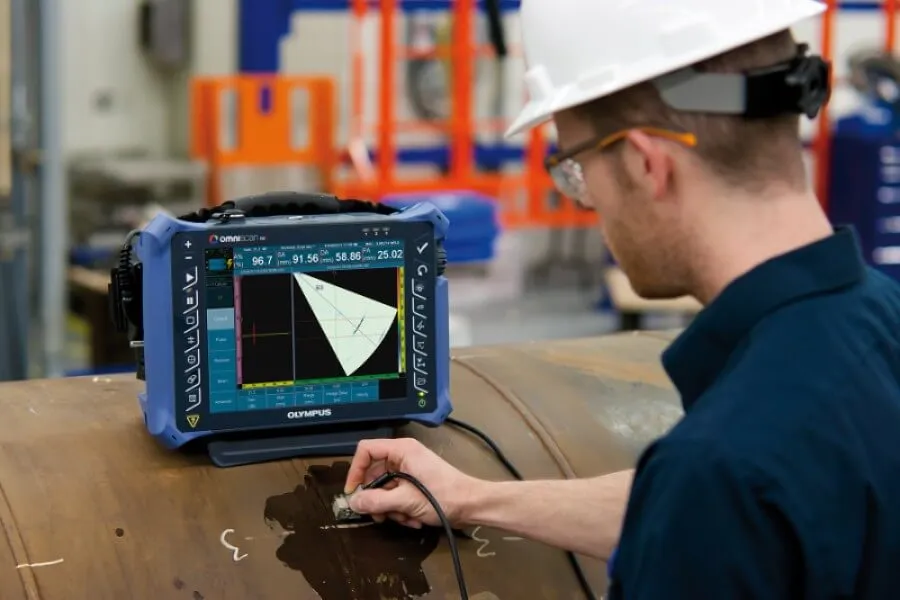Table of Contents
- Introduction
- What is Ultrasonic Testing?
- Basic Principles of Ultrasonic Testing
- Terminologies You Need to Know for Ultrasonic Testing
- Conclusion
- Key Takeaways
- FAQs
Introduction
Ultrasonic testing involves the use of high-frequency sound waves to detect and evaluate flaws or abnormalities in materials.
It is widely employed across various industries for its accuracy and non-invasive nature.
Ultrasonic Testing terminologies might sound like a term from a science fiction movie, but in reality, it's a crucial aspect of various industries.
What is Ultrasonic Testing?
Ultrasonic testing is a Non-destructive Testing (NDT) method that uses high-frequency sound waves to detect flaws or measure the thickness of materials.
It's like giving materials an echo and listening to what comes back.
As a cornerstone of the NDT Test, ultrasonic testing provides a reliable method for assessing the internal structure of materials without causing damage.
This is particularly crucial in industries with ultrasonic testing for welds and steel and Ultrasonic Testing on Tanks/Pipelines.

Basic Principles of Ultrasonic Testing
Understanding ultrasonic testing requires knowing a few key principles.
Here are the basic principles of Ultrasonic Testing Inspection.
1. Generation of Ultrasonic Waves
Ultrasonic inspection relies on the generation of ultrasonic waves through an Ultrasonic Transducer.
These waves travel through the material, and the reflected waves are analyzed to determine material properties. This plays a crucial role in ultrasonic NDT Testing.
2. Interaction with Materials
Factors such as density, elasticity, and acoustic impedance influence wave behavior, so the interaction with materials is the key to Ultrasonic Examination.
3. Detection and Measurement
Accurate detection and measurement are key Ultrasonic Testing Applications and are essential for interpreting results.
Advanced equipment ensures precise analysis using NDT ultrasonic testing.
Terminologies You Need to Know for Ultrasonic Testing
Ultrasonic Test plays a pivotal role in ensuring the structural integrity of materials without causing any harm.
Ultrasonic Testing Methods involve the use of high-frequency sound waves to detect and evaluate flaws or abnormalities in materials.
Here are a few important ultrasonic testing terminologies.
1. Ultrasonic Waves
Ultrasonic Waves can be assumed to be sound waves on steroids.
They travel through materials and bounce back, revealing the material's internal structure. These developments are from NDT Techniques.
2. Transducer
The Ultrasonic Transducer is the key element of ultrasonic testing.
It sends and receives ultrasonic waves, acting as our ears and voice in the Ultrasonic Testing Procedure.

3. Pulse-Echo Technique
The ultrasonic NDT Technique involves sending short bursts of ultrasonic waves and measuring the time it takes for them to return.
It's like sending a message and waiting for the reply to gauge the distance.
4. Attenuation
Attenuation is like the fading of your voice in an echoey canyon.
It's the reduction in intensity as Ultrasonic Waves travel through a material.
5. Amplitude
Amplitude is the height of the ultrasonic wave. It's like the volume of music the higher, the better.
6. Time-of-Flight
Time-of-flight is the time it takes for ultrasonic waves to travel through a material and return.
It's like timing how long it takes for a friend to respond to your message.
7. Sound Velocity
This is the speed of ultrasonic waves in a material.
It's like knowing how fast your voice travels in different environments.
8. Gain
Think of gain as the volume control for Ultrasonic Waves. It helps us fine-tune the sensitivity of the testing.
9. A-Scan
A-Scan is like the heartbeat monitor of Ultrasonic Testing. It displays the amplitude of ultrasonic waves over time.
10. B-Scan
B-Scan is the visual representation of ultrasonic waves moving through a material. It's like creating a map of the unseen world within.
11. C-Scan
C-Scan is the superhero vision of Ultrasonic Testing. It provides a 2D representation of flaws in a material.
12. DAC/TVG
DAC/TVG is the wizardry that corrects variations in the amplitude of ultrasonic waves. It ensures accurate readings.

13. Refraction
Refraction is like the bending of light but in the ultrasonic world.
It happens when waves change direction as they pass through different materials.
14. Snell's Law
Named after a physics hero, Snell's Law governs how Ultrasonic Waves change direction at the interface of materials. It's like knowing the rules of a game to play it well.
15. Back Wall Echo
The back wall echo is the friendly bounce-back of Ultrasonic Waves from the far side of a material. It's like getting a reassuring reply from a friend on the other side.
16. Dead Zone
Just like a blind spot in your car, the dead zone is an area near the transducer where ultrasonic waves might not be detected.
17. Near Field and Far Field
These are like the front row and back row in a concert. The near field is close to the Ultrasonic Transducer, and the field is where the action happens at a distance.
18. Velocity Calibration
Velocity calibration ensures that ultrasonic waves are on the right track, just like tuning an instrument before a performance.
19. Thickness Measurement
Finally, Thickness Measurement is the endpoint of knowing how thick or thin a material is, a bit like checking battery level in ultrasonic NDT.
Conclusion
Ultrasonic Inspection in the future is like giving materials a voice, allowing us to understand their inner workings without invasive procedures.
As technology advances, like that of applications for underwater ultrasonic testing so does our ability to explore the ultrasonic testing benefits.
Future trends include AI integration, miniaturization of equipment, and improved data visualization in Ultrasonic Testing NDT using ultrasonic testing terminologies.
Choosing the right Ultrasonic Testing Equipment using UT terminologies depends on industry standards, portability, ease of use, and cost-effectiveness in NDT techniques.
Key Takeaways
- Ultrasonic Testing is a pivotal non-destructive testing method widely used across industries for its accuracy and non-invasive nature.
- Serving as a cornerstone in NDT, ultrasonic testing provides a reliable method to assess the internal structure of materials without causing damage.
- Ultrasonic testing is particularly crucial in industries involving welds, steel, tanks, and Pipelines, ensuring structural integrity without harm.
- Ultrasonic testing involves key principles such as the generation of ultrasonic waves, interaction with materials, and accurate detection and measurement.
- Ultrasonic testing terminologies may sound complex but are crucial for maintaining structural integrity without causing harm.
- These high-frequency sound waves, akin to sound waves on steroids, travel through materials and bounce back, revealing internal structures.
- The key element in Ultrasonic Testing, the transducer, acts as ears and voice, sending and receiving ultrasonic waves.
FAQs
1. What are the basics of ultrasonic testing?
A: Ultrasonic Testing involves the use of high-frequency sound waves to detect flaws or irregularities in materials non-destructively.
2. What is the term frequency used in ultrasonic testing?
A: Term frequency refers to the number of sound wave cycles per unit of time, influencing the depth of penetration and resolution in the testing process.
3. What are the parts of an ultrasonic tester?
A: Key components include the Ultrasonic Transducer, receiver, and display unit, each playing a crucial role in the testing process.
4. What are the five common probes used in ultrasonic testing?
A: Examples include contact probes, angle probes, and dual-element probes, each designed for specific applications and material types.
5. What is the range of the UT probe?
A: The range of UT probes varies based on their type and frequency, influencing the depth of penetration and the size of detectable flaws.









